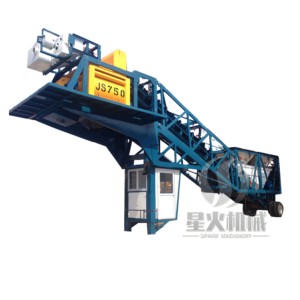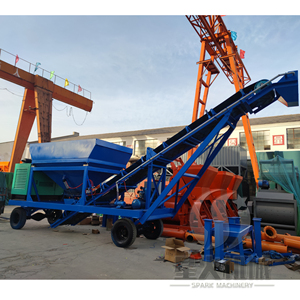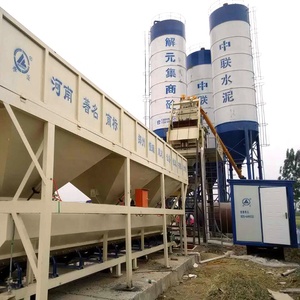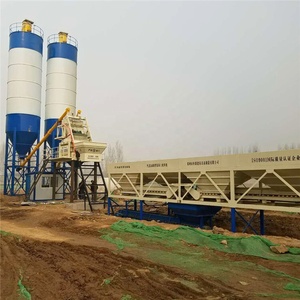
All categories
Featured selections
Trade Assurance
Buyer Central
Help Center
Get the app
Become a supplier

(5382 products available)








































Concrete is a mixture of water, cement, sand, and aggregates that, when combined in the right proportions, will yield a stable building compound. There's no need for an on-site mixing facility for concrete in the form of a dry mix because, before its arrival at the building site, everything has already been done but one thing - the addition of water. A dry mix concrete plant, which comes in two primary categories, the batch plant and the continuous plant, is helpful in this instance. In a batch plant, concrete is made in small amounts and then transported by a truck that has mixing equipment on it so it doesn't set until it reaches its destination.
The first step in knowing how a dry mix concrete plant works is recognizing that different types produce concrete, some more efficiently than others. Understanding what type of plants there are provides insight into their productivity and effectiveness. Generally, they can be divided into two large classes, stationary and mobile, with many models under each category, such as a wet mix plant or a batching plant.
Stationary dry mix concrete plants
Mobile dry mix concrete plants
A mobile concrete plant is more compact than stationary ones so that it can be moved easily. They come in modular form, which makes transportation and assembly easier.
Skip hoist dry mix concrete plant
A skip hoist plant uses a skip or bucket to lift mixed concrete vertical. This system is used in smaller production capacities where the height of the plant is an advantage to using it at that elevation rather than having a horizontal belt transfer the materials.
Screw conveyor dry mix concrete plant
This plant uses a screw conveyor to horizontally or vertically transport materials. Screw conveyors are known for their efficiency and ability to handle a variety of material consistencies.
Dry mix mortar concrete plant
It produces dry mix mortar, which is a pre-mixed malter for laying bricks, tiles, masonry, repairing, and plastering. The plants heat, dry, and screen aggregates to ensure the final product has the desired quality and consistency.
It is crucial for the plants' efficiency and longevity to regularly monitor and maintain the dry mix concrete plant. The following are some typical maintenance procedures:
A dry mix concrete plant offers many usage scenarios primarily based on supply and demand. The following are some concrete plant usage scenarios based on the application sectors corresponding to the installation and configuration of the equipment.
Choosing the right dry mix concrete plant for sale is a challenging task. Buyers must consider many factors before making the final decision. Start considering the key parameters of the plant that will have an impact on the production capacity. Select the materials and equipment that match the required output. A suitable plant model is one whose specifications match the requirements of the project. Then consider the construction time. If the plant needs to be completed before a specified date to allow for the start of further stages of the construction process or the commissioning of the product, it is important to choose the dry-mix concrete plant whose installation will meet the deadline nicely.
Also) consider the logistical difficulties that may arise in transporting the plant to the required location if the chosen plant will not be located near a source of raw material and the market for the end product. At the same time, the capacity of the buyer's business must be assessed in terms of financial resources and staff training. It may also be important to know whether the required plant is available or whether a customized version will have to be ordered, as in some cases it would be possible to have a more advanced plant at a lower cost if certain features were excluded.
Buying requires a study of the suppliers' technical expertise, the after-sales services offered, including maintenance and training, the suppliers' reputation in the market, and references from other customers. In addition to the warranty period for the equipment, the quality of the equipment should be evaluated, as it will determine the level of concrete production. It is important to realize that ordering a concrete plant is a big step for the future of the business, and care must be taken to ensure that it adds value.
Q1 What is the difference between a dry and wet mix concrete plant?
A1 The mixing methods and end product are different. In a dry mix concrete plant, all the ingredients are mixed in a concrete truck or mixer before being discharged. In a wet mix plant, the materials are mixed thoroughly in a central mixing unit and then discharged as a homogeneous mix.
Q2. What is the total worth of the global dry mix concrete market?
A2 According to recent reports, the global dry mix concrete market was valued at $1,020 million in 2021 and is estimated to reach $1,288.1 million by 2027, with a growth at a CAGR of 3.7% from 2021 to 2027.
Q3 What are some trends in the dry mix concrete plant market?
A3 The demand for high-performance building materials will likely boost the use of dry mix concrete. Furthermore, the environmental requirement will likely boost the production of eco-friendly dry mix concrete. Finally, automation in dry mix concrete plants will enhance production efficiency.
Q4 How does a dry mix concrete plant affect the environment?
A4 A dry mix concrete is more environmentally friendly in that it will use less water and therefore reduce the risk of water pollution, while some plants recycle waste water. Furthermore, some dry mix concrete plants will use alternative energy sources, such as solar or wind power, to reduce CO2 emissions and save energy.